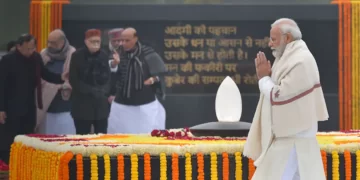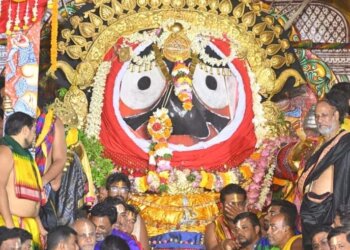Santiniketan, the cultural and educational center founded by Nobel laureate Rabindranath Tagore, has been inscribed on UNESCO’s World Heritage List. This honor is noteworthy for India and recognizes the enduring legacy of this one-of-a-kind institution in Bengal’s Birbhum region.
India has long sought UNESCO recognition for Santiniketan, recognizing its cultural and historical value. The decision to include Santiniketan on the renowned list was taken during the World Heritage Committee’s 45th session, which was held in Saudi Arabia, underlining its prominence on the global stage.
Santiniketan is a historic site, as well as the location where poet Rabindranath Tagore built Visva-Bharati over a century ago. The 45th World Heritage Committee Meeting in Riyadh, Saudi Arabia, made the decision to add Santiniketan on the list.
“New inscription on the @UNESCO #WorldHeritage List: Santiniketan, #India. Congratulations!” UNESCO posted on X, formerly known as Twitter.

The UNESCO Recognition
A Glorious Achievement
The inclusion of Santiniketan on the UNESCO World Heritage List attests to its cultural and educational importance. This honor underscores the importance of conserving and promoting Rabindranath Tagore’s legacy and the institution he founded.
India’s Standing on the World Heritage List
With this recent addition, India has risen to sixth place on the World Heritage List, demonstrating the country’s dedication to preserving its cultural and natural assets. The addition of Santiniketan strengthens India’s position as a custodian of world heritage. Santiniketan is officially India’s 41st World history site, cementing its place in the country’s rich cultural history.
SANTINIKETAN
The environment is always present in one’s consciousness at Santiniketan. It becomes a part of one”s being here more than everywhere else, which is why it grows on you and it is tough to forget having lived here once. With its inhabitants, the Santiniketan ecosystem has altered, expanded, and evolved.
Santiniketan is located 200 feet above sea level, creating a slight bulge in an otherwise flat area. The earth gradually falls to 100 feet above sea level at the Ajay river, which is about 3 miles to the south, and the Kopai stream, which is about 2 miles to the north. Santiniketan’s southern limit merges with a large plain of rice fields. The khoai fields with severely incised gullies caused by erosion over denuded land. The District Gazetteer of Birbhum records that in pre-British days, Birbhum had an extensive forest cover. Progressive denundation of forests played havoc with the porous laterite soil. During the hot months, fierce dust storms scattered the loose soil far and wide. During the rains heavy erosion took place as after every downpour water rushed through undulating land creating gullies and gorges in its relentless march.
This arid terrain provided comfort and serenity to Maharshi Devendranath Tagore in the mid-nineteenth century. He bought the site and immediately began building a house. Santiniketan House was built in the early 1860s; the name later came to describe the entire neighborhood. A lovely garden was planted on all four sides of the house. The top layer of gritty dry dirt was scraped away and replaced with lush material brought in from the outside. Fruit and shade trees were planted.
The environment was changing.
Rabindranath accompanied his father to Santiniketan as a kid and later remembered in Reminiscences, “Though I was still a mere child, my father did not place any restriction on my wanderings.” In the crannies of the sandy soil the rain water had ploughed deep furrows, carving out miniature mountain ranges full of red gravel and pebbles of various shapes through which ran tiny streams, revealing the geography of Lilliput… I was never tired of roaming about among those miniature hills and dales in hopes of lighting on something never known before.
When Rabindranath began his Brahmacharyasrama in 1901, he discovered it “flanked on the south by a sal avenue and an entrance gate covered by a canopy of Madhavi creepers.” An orchard of mango trees lay to the east. A few palmyra palms, jamun, casuarina, and coconut palms may be found to the west. The two ancient Chhatim trees stood on the northwestern outskirts of the old asrama.”Rabindranath”s choice of Santiniketan for his school was undoubtedly influenced by its setting. He has written in “My School”:
“I selected a beautiful place, far away from the contamination of town life, for I myself, in my young days, was brought up in that town in the heart of India, Calcutta, and all the time I had a sort of homesickness for some distant lane somewhere, where my heart, my soul, could have its true emancipation… I knew that the mind had its hunger for the ministrations of nature, mother-nature, and so I selected this spot where the sky is unobstructed to the verge of the horizon. There the mind could have its fearless freedom to create its own dreams and the seasons could come with all their colours and movements and beauty into the very heart of the human dwelling.”
Seasonal celebrations were always a part of the asrama. These festivals became associated with the unique culture of this institution, and the incorporation of traditional Indian forms and rituals in their organization, such as the decoration of the site, the use of flowers, alpana, the chanting of Vedic hymns, and the blowing of conch-shells, gave them a new dimension, aesthetically appealing, intrinsically Indian yet completely secular. Rabindranath believed that an affinity between the brains of the pupils and the flora and wildlife of the asrama was required.
Learning was always intended to be a natural component of life”s growth at Santiniketan. The first step toward achieving this goal was to instill in the youngster a sense of oneness with nature. A child has to be aware of his surroundings – the trees, birds and animals around him. The mind is deprived if one is indifferent to the world outside. Rabindranath said we concentrate on learning from books and neglect the knowledge that is freely available on all sides.
He wanted his students to be aware of their surroundings, to communicate with them, to investigate them, to do experiments, and to gather data and specimens. And he desired teachers who could go beyond book learning, who were seekers themselves, and who found delight in the process of learning to guide others. In this perspective, Tejeschandra Sen, along with Jagadananda Roy, was one of India’s pioneering professors of Nature Study. They were successful in instilling in children a love of and interest for the natural world. Lord Haldane, who visited Santiniketan in 1954, was quite impressed with Tejeschandra’s teaching technique.
To avoid future khoai erosion, dirt embankments were erected in the mid-1950s, creating little lakes of moderate size. The bunding of the Mayurakshi river some distance on the north-west brought Santiniketan a branch of an irrigation canal which forms its northern boundary. Thus started, the greening of khoai brought about significant changes in the environment. An extensive forest has been created where deer graze.
However, Santiniketan is now a botanist’s paradise. Plants, trees, creepers, and orchids from all across India and the world have been cultivated to thrive in this previously semi-desert environment. Rabindranath takes a keen interest in tree planting. In 1928, he popularized the concept of Vriksharopana, or tree-planting ritual. Rathindranath, his son, was a trained gardener who introduced many new trees and plants to Santiniketan. Fortunately, the Santiniketan community as a whole shares this passion for trees and gardening. The seasons are plainly identified in Santiniketan; the looks and smell of blossoms in bloom signal the end of one season and the beginning of the next.
Children appear to be as joyful and free as they have always been. Even now, classes are held under the trees. The first day of rain is still marked by an outing, barefoot and without umbrellas. Rabindranath’s soul lives on in Santiniketan; one must be aware of it and step lightly so as not to disturb it.
Source:VV







 Finance
Finance







